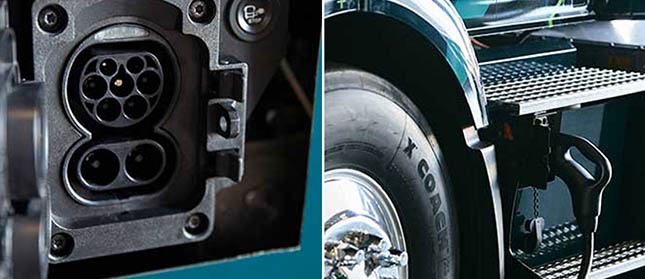Fleets and OEMs testing commercial electric truck viability in the U.S. are learning some lessons about ongoing challenges in rolling out a nationwide charging network.
Momentum is growing for heavy-duty electric truck adoption, but a lot of work remains for successful, full-scale fleet adoption, reports Fleet Owner.
Charging infrastructure remains a problem, and an entire ecosystem around infrastructure, charging needs, and funding is needed to push electrification for commercial trucks. And those who are testing electric trucks in southern California believe there is an evolution that will take the better part of this decade to meet the expectations of today’s heavy-duty applications.
Along their electrification journeys, both DTNA and Volvo are learning the value of partnerships and real-world testing. But both OEMs are also looking to make sure that they are developing electric trucks that fulfill the industry’s high-quality expectations.
“Those are the kind of partnerships we need going forward to further increase the zero-emission penetration,” noted Michael Scheib, head of product management for DTNA. “So, it is not the OEM only. We still need to work on getting the cost down on these products to get to a TCO [total cost of ownership] level. We also need the infrastructure because it is one of the biggest impacts for TCO to make these products successful in the market.”
Scheib added that when it comes to TCO, certain segments will see a faster payback for electric trucks. DTNA created an internal service for charging infrastructure at customer depots, worked with its dealer network to prepare qualified dealers for repairing electric trucks, and built a site called “Electric Island” to fully test charging infrastructure.
“We are definitely looking into hardware for infrastructure because the single, number-one failure we had in the Innovation Fleet is the failure to charge,” Scheib pointed out.
DTNA also learned the hard way that if charging stations are on a slight slope and a truck is plugged in without emergency brake activation, the truck is at risk of rolling away.
“We had this happen too,” Scheib said.
VTNA also learned first-hand the value of collaboration with various partners throughout the Volvo LIGHTS project, noted Keith Brandis, vice president of Partnerships & Strategic Solutions.
Two VTNA fleet customers DHE and NFI agreed to put roughly 23 Volvo VNR battery-electric trucks into their fleet and run daily operations.
Volvo VNRs retrofitted with electric drivelines have already been proven over hundreds of thousands of miles with Volvo buses and medium-duty trucks in Europe, Brandis noted.
“Charging infrastructure has been one of the larger challenges for us in this project,” Brandis stressed. “Each locality has their own inspection, permitting, and approval processes, so we have to get very granular. I think it’s going to be quite a challenge to rollout a nationwide charging network until we have more standards in place and until we are able to move even faster to charging level supplier.
“We are making sure that each site is fully energized and commissioned with reporting back to the fleet owner so they can see how much energy is being used and the state of charge of each vehicle, so the fleet owner has the tools that they need to make the decisions on whether that truck is ready to go, which route it can be put on, and how the fleet can get the maximum benefit,” he continued.
When conducting site assessments and walkarounds with fleets, VTNA’s Brandis pointed out that real estate is incredibly expensive in southern California and that carving out a portion of a fleet’s facility for charging infrastructure is disruptive to a fleet’s entire operation. Fleets have expressed concerns of their depots being under constant construction with congestion and moving equipment around with more widespread electric truck adoption.
Full Fleet Owner story here.
